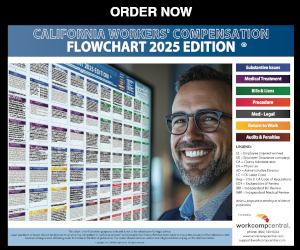Industry Insights
July 11, 2023
Young: State's Top Workers' Comp Developments — First Half of 2023
- State: California
- - 0 shares
At mid-2023, it’s time to examine the most important developments in California workers’ compensation so far this year.

Julius Young
If one tried to separate the wheat from the chaff, what is significant? Here, in no particular order, are my picks:
1. Bills sponsored by labor groups, applicants' attorneys and employee advocates continued to advance through the Legislature.
The California Assembly has a new majority leader. Robert Rivas, D-Hollister, has succeeded Anthony Rendon as speaker.
Many stakeholders believe that the current Democratic legislative supermajority is much more sympathetic to tweaking the 2004 and 2012 California workers’ comp reforms than in recent years. Several of the bills in play would either tweak prior comp reforms or expand benefits to selected public safety personnel and state employees.
In the following list, I’ve included other pending bills that, while not strictly about workers’ comp, do pertain to employee rights/employer obligations and thus may come into play in some work injury situations. Some would expand employee rights in specified situations.
As of early July 2023, the following bills have passed either the California Assembly or Senate and appear in play:
- AB 1213 (Ortega) waives the cap on temporary disability benefits for periods of denied treatment when utilization review denial is overturned by independent medical review. This bill is celebrated by work advocates as a measure of fairness to workers. It is opposed by the insurer-employer coalition that cites a California Workers' Compensation Institute analysis that claims the limited number of cases that would benefit do not justify the expense.
- AB 1145 (Maienschein) provides an industrial presumption for post-traumatic stress disorder for certain employees of state hospitals and the Department of Corrections.
- AB 623 (Laird) extends peace officer PTSD presumption to 2032 and provides PTSD presumption for firefighters and emergency dispatchers.
- AB 621 (Irwin) expands a special death benefit, allowing PERS special death benefit and workers' comp death benefit.
- SB 391 (Blakespear) is a skin cancer presumption for state Fish and Wildlife and Parks and Recreation workers.
- SB 626 (Cortese) requires UR physicians and psychologists to be licensed in California.
- SB 631 (Cortese) requires the Division of Workers' Compensation and UC Berkeley, rather than the Commission on Health and Safety and Workers' Compensation, to conduct an analysis of differences in workers’ comp benefits other than medical treatment provided to employees of different genders.
- SB 697 (Hurtado) would require a DWC study of a value of care reimbursement system. Although this bill passed the Senate, an Assembly hearing was canceled in late June.
- AB 336 (Cervantes) requires contractors to certify workers’ comp insurance policy class codes when renewing their contractor licenses. As of late June, this bill was placed in the Senate Appropriations Committee suspense file, as there may be issues about the cost impact to the state.
- AB 594 (Maienschein) expands and strengthens the right of public prosecutors to enforce California labor laws such as those dealing with labor standards, wage theft and worker misclassification, but not workers’ comp laws.
- SB 731 (Ashby) requires an employer, before requiring a home-based employee to return to work in person, to provide at least 30 calendar days' written notice to the employee, along with a statement about the right to seek an accommodation.
- SB 553 (Cortese) requires workplace violence prevention plans, prohibits retaliation if an employee seeks assistance from law enforcement or emergency services after a violent incident, and allows a collective bargaining representative to file for a temporary restraining order on behalf of an employee who has suffered unlawful violence or a credible threat of violence. Sponsored by the United Food and Commercial Workers, this bill reflects rising concern about violence against workers, including retail employees.
- SB 723 (Durazo) modifies recall and reinstatement rights for laid-off employees in the hospitality, service and travel industries and deletes a prior sunset date.
- AB 1356 (Haney) revises the WARN Act to include a “client employer” or a labor contractor in the definition of an employer, and among other provisions increases from 60 days to 90 days the length of notice an employer must provide to employees prior to terminations, relocations or mass layoffs.
- SB 616 (Gonzalez) among other things, expands the amount of paid sick leave employers are required to provide employees, from three days to seven.
- SB 627 (Smallwood-Cuevas) creates a Displaced Worker Retention and Transfer Rights Act and prohibits chain employers from closing without giving a 60-day notice. It also requires a chain employer to provide transfer opportunities to other chain locations within 25 miles as positions become available.
2. In 2023, there are important workers’ comp and worker rights developments in the courts.
Among the workers’ comp cases worthy of mentioning are the following:
In early July, the California Supreme Court released its decision in Kuciemba v. Victory Woodworks. Mr. Kuciemba’s wife had sued her husband’s employer after she claimed she contracted COVID from the husband’s alleged workplace exposure. The court framed the issues as follows:
The questions are: (1) If an employee contracts COVID-19 at the workplace and brings the virus home to a spouse, does the California Workers’ Compensation Act (WCA; Lab. Code Sec. 3200 et seq.) bar the spouse’s negligence claim against the employer? (2) Does an employer owe a duty of care under California law to prevent the spread of COVID-19 to employees’ household members?
While the decision holds that California workers’ compensation does not bar such an action, the employer does not have a duty of care, given the circumstances of the COVID pandemic. The court reasoned as follows:
[A] duty of care to nonemployees in this context would impose an intolerable burden on employers and society in contravention of public policy. These and other policy considerations lead us to conclude that employers do not owe a tort-based duty to nonemployees to prevent the spread of COVID-19.
The California Supreme Court announced on June 28 that it agreed to hear Castellanos v. State of California (Protect App-Based Drivers and Services). Gig employers such as Uber, Lyft, Doordash, etc., that sponsored Proposition 22 had largely prevailed at the 2st District Court of Appeal in Hector Castellanos v. State of California.
• Grace Nunes v. State of California and Dept. of Motor Vehicles (WCAB en banc): While it is not an appellate court decision, this en banc ruling is important, as it sets forth rules regarding use of vocational expert opinions in cases where apportionment is an issue and indicates that medical apportionment is the standard under Labor Code 4663, not “vocational apportionment.” This decision may affect a number of cases currently in litigation, as parties may need to seek clarification from qualified medical evaluators, agreed medical evaluators and retained vocational experts. The Nunes decision can be seen here.
• State of California ex rel. Anna Maria Christina Sills v. Bahar Gharib-Danesh (2nd DCA): a qui tam action arising out of alleged workers’ comp provider fraud not barred by the “five-year rule” where the case was under seal during part of that time.
• Adolph V. Uber Technologies (case argued at California Supreme Court in May 2023 and pending at the time of this post): Although this is not a workers’ compensation case, it does deal with issues that are important to workers and employers. At issue is whether, under the 2004 Private Attorneys General Act (PAGA), employees can sue employers either individually or collectively for labor law violations and how state law fits with the Federal Arbitration Act.
3. COVID impact on California receded and emergency regs expired.
The official COVID state of emergency ended in February 2023. But as of mid-June, 320,714 COVID claims had been filed and there were 1,641 reported work-related death claims during the course of the pandemic. In May 2023, there were 841 reported claims of alleged work-caused COVID, as reported COVID claims declined each month of the year. However, the COVID presumptions of industrial causation enacted under AB 1751 are still in effect and expire as of Jan. 1, 2024.
Meanwhile, COVID-specific sick pay requirements under SB 114, AB 152 and Cal/OSHA regulations have expired.
And Cal/OSHA has adopted nonemergency COVID prevention rules. On Dec. 15, 2022, the Occupational Safety and Health Standards Board established nonemergency COVID-19 prevention regulations. They were effective Feb. 3.
A link to COVID claims stats can be found here.
A June 2023 Workers' Compensation Insurance Rating Bureau study of “Long-Term COVID” analyzed the extent of long COVID in the California system, as well as the impacts of long COVID on permanent disability. The report noted that “13% of COVID-19 claims with medical payments received treatments for long COVID symptoms in the workers' compensation system.” Researchers also found, “[T]he average incurred medical costs for long COVID claims involving PD benefits are almost three times as high as other COVID-19 claims involving PD benefits.”
4. Regulatory activity by the DWC in the first half of 2023 was modest.
In February, the Division of Workers' Compensation adopted QME regulations that essentially continue allowance for remote telehealth QME evaluations, as long as an in-person, hands-on eval is not necessary and certain requirements are met.
The regs also loosen time frame requirements for QMEs to schedule appointments, loosening the time to 90 days from the appointment request (or up to 120 days if the 90 days are waived).
While some workers’ comp stakeholders believe the amended scheduling rules will decrease the need for replacement panels, many applicants' attorneys are concerned that the longer allowed scheduling time frames will simply add to delays in obtaining benefits for clients and lengthen the time to process cases.
At midyear, another set of QME regulations was still in development, as a 15-day comment period ended in late May after a public hearing. Those regs would address a variety of issues, including revisions to QME continuing education requirements, QME reappointment rules, rules pertaining to QME discipline and a repeal of regs related to Supplemental Job Displacement Benefit benefits. A link to the DWC regs page can be seen here.
And the DWC has announced a July 18 public hearing to hear input regarding an update to the workers’ compensation audit regulations.
5. AB 5 and Prop. 22 remained in issue in 2023.
Although the California workers’ comp system has not been flooded with claims alleging that gig workers are covered by workers’ comp, observers are keeping an eye on how uncertainty about AB 5 and Prop. 22 play out.
The gig companies won an appeal of an Alameda County Superior Court ruling that had held Prop. 22 was unconstitutional as a violation of the single-subject rule and a violation of the Legislature’s plenary power over workers’ compensation under the California constitution. That 2-1 March decision, Hector Castellanos v. State of California/Protect App-Based Drivers and Services, did, however, find that certain provisions of Prop. 22 are invalid because they intrude on the judiciary’s authority to determine what constitutes an amendment to Prop. 22.
The 1st District Court of Appeal will not be the last word on the constitutionality of Prop. 22. As noted above, the California Supreme Court has agreed to hear the Castellanos case.
But while labor advocates were attacking Prop. 22, the gig platform companies have been attacking AB 5, which codified the California Supreme Court adoption of the ABC employment test in the Dynamex case. On March 17, the U.S. Court of Appeals for the 9th Circuit ruled in Lydia Olson v. California, a challenge to AB 5 filed by Postmates, Uber and two driver plaintiffs. That challenge had been dismissed by the Federal District Court, but the 9th Circuit panel found that AB 5 violated the equal protection clause, noting many legislative exemptions from AB 5 and media quotes from key legislators. In May, California’s attorney general filed a request for a rehearing at the 9th Circuit.
Olson had a different result than that in an earlier 9th Circuit Case, Mobilize the Message v. Bonta, where another panel found 2-1 that AB 5 did not violate the free speech of ballot signature gatherers. The U.S. Supreme Court refused to hear the case.
The case of Lawson V. Grubhub is an example of some of the legal uncertainty that has surrounded gig workers. Grubhub initially won a U.S. District Court ruling that a driver was an independent contractor under the Borello case. At the 9th Circuit level, Grubhub lost, as the 9th Circuit remanded for the court to apply the ABC test on the pre-Prop. 22 claims. Upon remand, the federal District Court found that under the ABC test, the worker was not an independent contractor.
Future rulings in the Castellanos and Olson cases may well determine whether gig-worker claims come into the California workers’ comp system or whether many app-based drivers are covered only under the limited compensation provisions of Prop. 22.
6. From a macro view, California’s workers’ comp system remained stable.
Macro views of the system don’t tell the story of individuals who find themselves injured at work or involved in a litigation process. A work injury may destabilize the worker’s health, his economic future and create hardship for families. So we must always keep the impact on individuals in mind.
However, from a macro standpoint, the system is stable.
Workers’ compensation insurance rates (both advisory and rates actually charged) have declined steadily since 2015. The WCIRB filed a request for an advisory rate of $150 per $100 of payroll, and a Department of Insurance hearing was held on June 7. At mid-year, Commissioner Ricardo Lara had yet to make a ruling.
The WCIRB’s rate request was modest, as it seeks a 0.3% increase in the advisory (non-binding) rate.
In a presentation, the WCIRB noted the following factors:
- Modest downward indemnity loss development (permanent disability claims as a share of indemnity claims at an all-time low).
- Stable medical loss development (medical utilization declined over the last decade and utilization declines have largely offset increases in cost per service).
- Claim frequency flat (declining 1% annually since 2007).
- Potential medical inflation.
- COVID activity settling down.
A link to the WCIRB’s charts can be seen here.
7. As always, there were studies of the California workers’ comp system.
System studies are often cited by business journalists and used by policymakers. Unfortunately, the applicants' attorney bar and labor advocates do not provide independent studies of the system. Most studies are done by the CWCI, affiliated with California insurers or by the quasi-public WCIRB.
Notable 2023 studies to date include the following:
- WCIRB report on 2022 quarterly experience.
- WCIRB June 27 report on 2022 California workers’ compensation losses and expenses.
- A draft CHSWC 2022 annual report that will likely be approved this month.
- May CWCI report on factors that drive IMR volume and outcomes.
- A June UC Berkeley Labor Center report on how the ABC test covers most of California’s alleged independent contractors.
- CWCI May study of low volume/high-cost dermatological, opioids and antidepressants.
- CWCI February study of low volume/high cost anti-inflammatory and anti-convulsant medications.
- DWC report on 2021 independent medical review.
- January CWCI study of inpatient care utilization.
- March CWCI study of workers’ comp medical service treatment patterns.
- UC Berkeley Labor Center study on independent contracting in California.
Stay tuned. The second half of 2023 promises to be interesting.
Julius Young is an applicants' attorney and a partner for the Boxer & Gerson law firm in Oakland. This column was reprinted with his permission from his Workers Comp Zone blog on the firm's website.
Advertisements
Columns
- Paduda: California Comp Drivers, Part 2 08/13/25
- CAAA: DWC Fumbles UR Rulemaking 08/12/25
- Paduda: California Comp Drivers, Part 1 08/11/25
- Langham: Bias Is Pernicious 08/08/25
- CAAA: Workers Can't Wait for Heat Protection 08/06/25
- Montgomery: State's Mandatory E-Billing Process Arrives 08/04/25
- CAAA: Audit Exposes Deep Failures at Cal/OSHA 07/30/25
- Paduda: Work Comp Remains the Darling of P&C Industry 07/28/25
- Wroten: The Flip Side of Regulations 07/25/25
- Moore: Were We Right About Comp in 2022? 07/23/25
- Kamin: WCIRB Says Carriers Losing Money Due to Rising Costs 07/21/25
- Paduda: What's Happening in Golden State Work Comp? 07/18/25
- CAAA: Fireworks Warehouse Blast Exposes Flaws in Safety, Oversight, Accountability 07/16/25
- Gelman: Asbestos Ban Is a Win for Workers 07/14/25
- Snyder: Mediation Confidentiality 07/11/25
- Snyder: Settle and Sue: Don't Let It Happen to You 07/09/25
- Kamin: State Senate Committee to Consider SIBTF Bill 07/07/25
- Anders: Self vs. Professional MSA Administration: Which Is Right for the Injured Worker? 06/30/25
- Geaney: Court Affirms Finding of Police Officer's Joint Employment 06/27/25
- Fricker: A New Era for Comp Subrogation 06/25/25
Now Trending
- Workers' Compensation News
-
Calif. Fire
Captain Accused of Filing Fake
Injury…
Posted on Aug 12, 2025
-
Calif. Company
President, Manager Charged With
Toxic Exposure,…
Posted on Aug 6, 2025
-
Ntl. Board Can
Reject Medical Opinion for
Confusing Legal, Clinical…
Posted on Aug 7, 2025
-
Nev. Bill
Increases Payroll Cap, Closes
Second Injury Fund, Requires ODG…
Posted on Aug 11, 2025
-
Maine Report: 98%
of Firefighter Cancer Claims
Initially Denied Despite…
Posted on Aug 13, 2025
-
Calif. Written
Premium Down 4% in 1st…
Posted on Aug 6, 2025
-
Wash. Flight
Attendant Gets Approval for Surgery
to Treat Back Injury From Rough…
Posted on Aug 12, 2025
-
Ore. Court Upholds
Dismissal of Suit Over Logging
Accident…
Posted on Aug 6, 2025
-
Texas Court
Revives Mother's Civil Suit for
Murder of Daughter by…
Posted on Aug 12, 2025
-
Minn. Worker Can
Recover Medical Costs Covered by
Non-Intervening Health…
Posted on Aug 8, 2025
Jobs
Upcoming Events
Aug 26, 2025
Claims Association of Greater
Join the Claims Association of Greater Chicago (CAGC) for a day of golf, networking, and fun at Th …
Sep 2-4, 2025
San Diego Elevate Workers' Com
We are thrilled to announce that Early Bird registration is OPEN for ELEVATE® 2025! This year's …
Nov 7, 2025
WIMAH 2025 Workers’ Compensati
Join Hawai'i’s premier workers’ comp event for expert insights, top-tier networking, and standout …
Social Media Links
c/o Business Insurance Holdings, Inc.
Greenwich, CT 06836




No Comments
Log in to post a comment